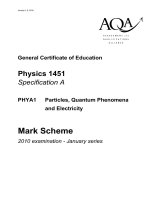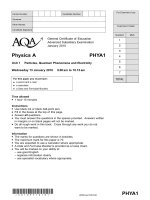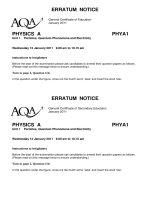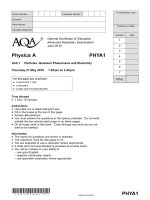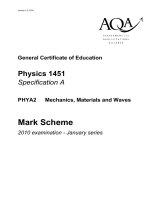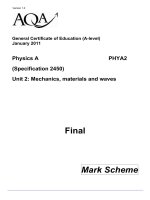- Trang chủ >>
- Khoa Học Tự Nhiên >>
- Vật lý
Vật lý A level: AQA PHYA4 w MS JUN12
Bạn đang xem bản rút gọn của tài liệu. Xem và tải ngay bản đầy đủ của tài liệu tại đây (352.48 KB, 8 trang )
Version 1.0
General Certificate of Education (A-level)
June 2012
Physics A
(Specification 2450)
PHYA4
Unit 4: Fields and further mechanics
Final
Mark Scheme
Mark schemes are prepared by the Principal Examiner and considered, together with the relevant
questions, by a panel of subject teachers. This mark scheme includes any amendments made at the
standardisation events which all examiners participate in and is the scheme which was used by them
in this examination. The standardisation process ensures that the mark scheme covers the
candidates’ responses to questions and that every examiner understands and applies it in the same
correct way. As preparation for standardisation each examiner analyses a number of candidates’
scripts: alternative answers not already covered by the mark scheme are discussed and legislated for.
If, after the standardisation process, examiners encounter unusual answers which have not been
raised they are required to refer these to the Principal Examiner.
It must be stressed that a mark scheme is a working document, in many cases further developed and
expanded on the basis of candidates’ reactions to a particular paper. Assumptions about future mark
schemes on the basis of one year’s document should be avoided; whilst the guiding principles of
assessment remain constant, details will change, depending on the content of a particular examination
paper.
Further copies of this Mark Scheme are available from: aqa.org.uk
Copyright © 2012 AQA and its licensors. All rights reserved.
Copyright
AQA retains the copyright on all its publications. However, registered centres for AQA are permitted to copy material from this
booklet for their own internal use, with the following important exception: AQA cannot give permission to centres to photocopy
any material that is acknowledged to a third party even for internal use within the centre.
Set and published by the Assessment and Qualifications Alliance.
The Assessment and Qualifications Alliance (AQA) is a company limited by guarantee registered in England and Wales (company number 3644723) and a registered
charity (registered charity number 1073334).
Registered address: AQA, Devas Street, Manchester M15 6EX.
Mark Scheme – General Certificate of Education (A-level) Physics A – PHYA4 – June 2012
3
Instructions to Examiners
1 Give due credit for alternative treatments which are correct. Give marks for what is correct in
accordance with the mark scheme; do not deduct marks because the attempt falls short of
some ideal answer. Where marks are to be deducted for particular errors, specific instructions
are given in the marking scheme.
2 Do not deduct marks for poor written communication. Refer the scripts to the Awards meeting
if poor presentation forbids a proper assessment. In each paper, candidates are assessed on
their quality of written communication (QWC) in designated questions (or part-questions) that
require explanations or descriptions. The criteria for the award of marks on each such
question are set out in the mark scheme in three bands in the following format. The descriptor
for each band sets out the expected level of the quality of written communication of physics for
each band. Such quality covers the scope (eg relevance, correctness), sequence and
presentation of the answer. Amplification of the level of physics expected in a good answer is
set out in the last row of the table. To arrive at the mark for a candidate, their work should first
be assessed holistically (ie in terms of scope, sequence and presentation) to determine which
band is appropriate then in terms of the degree to which the candidate’s work meets the
expected level for the band.
QWC
descriptor
mark range
Good - Excellent
see specific mark scheme
5-6
Modest - Adequate
see specific mark scheme
3-4
Poor - Limited
see specific mark scheme
1-2
The description and/or explanation expected in a good answer should include a
coherent account of the following points:
see specific mark scheme
Answers given as bullet points should be considered in the above terms. Such answers
without an ‘overview’ paragraph in the answer would be unlikely to score in the top band.
3 An arithmetical error in an answer will cause the candidate to lose one mark and should be
annotated AE if possible. The candidate’s incorrect value should be carried through all
subsequent calculations for the question and, if there are no subsequent errors, the candidate
can score all remaining marks.
4 The use of significant figures is tested once on each paper in a designated question or part-
question. The numerical answer on the designated question should be given to the same
number of significant figures as there are in the data given in the question or to one more than
this number. All other numerical answers should not be considered in terms of significant
figures.
5 Numerical answers presented in non-standard form are undesirable but should not be
penalised. Arithmetical errors by candidates resulting from use of non-standard form in a
candidate’s working should be penalised as in point 3 above. Incorrect numerical prefixes and
the use of a given diameter in a geometrical formula as the radius should be treated as
arithmetical errors.
6 Knowledge of units is tested on designated questions or parts of questions in each a paper.
On each such question or part-question, unless otherwise stated in the mark scheme, the
mark scheme will show a mark to be awarded for the numerical value of the answer and a
further mark for the correct unit. No penalties are imposed for incorrect or omitted units at
intermediate stages in a calculation or at the final stage of a non-designated ‘unit’ question.
7 All other procedures including recording of marks and dealing with missing parts of answers
will be clarified in the standardising procedures.
Mark Scheme – General Certificate of Education (A-level) Physics A – PHYA4 – June 2012
4
GCE Physics, Specification A, PHYA4, Fields and Further Mechanics
Section A
This component is an objective test for which the following list indicates the correct answers used in
marking the candidates’ responses.
Keys to Objective Test Questions
1
2
3
4
5
6
7
8
9
10
11
12
13
C
A
A
D
C
C
A
A
C
B
D
B
C
14
15
16
17
18
19
20
21
22
23
24
25
A
D
C
B
D
B
B
A
D
D
C
A
Section B
1
a
force is equal to (or proportional to) rate of change of momentum
[or impulse = force time = change of momentum]
[Answer should not be in symbols unless all the symbols are
explained]
1
1
b
i
use of mgh = ½ mv
2
gives v =
1.69.8122 gh
( = 5.60
m s
1
)
1
1
b
ii
momentum per second (= 0.30 5.60) = 1.68 (Ns)
1
1
b
iii
mass of sand falling in 10s = (0.30 10) (= 3.00 kg)
force due to arriving sand = momentum arriving per second = 1.68
(N)
equivalent mass reading =
9.81
1.68
(= 0.17 kg)
so balance reading is 3.00 + 0.65 + 0.17 ( = 3.82 kg )
3
1
c
horizontal lines up to 5 s and beyond 25 s
line of constant positive gradient between 5 s and 25 s
(near) vertical steps up at 5 s and down at 25 s
3
2
a
i
horizontal arrow to the left
1
2
a
ii
the electrostatic force is unchanged
2
Mark Scheme – General Certificate of Education (A-level) Physics A – PHYA4 – June 2012
5
because electric field strength is constant
2
b
i
forces are equal in magnitude but opposite in direction
(E is the same for both and) Q has same magnitude but opposite
sign
2
2
b
ii
acceleration of proton is (much) smaller (than acceleration of
electron)
because mass of proton is (much) greater (than mass of electron)
2
2
b
iii
acceleration of proton increases and acceleration of electron
decreases
correct reference to changing strength of electric field (for either or
both)
2
2
c
i
energy of photon
9
834
10650
103.00106.63
hc
E
= 3.06
10
19
(J)
energy required =
19
19
101.60
103.06
= 1.91 (eV)
3
2
c
ii
electric field strength
3
10180
4500
d
V
= 2.50 10
4
(V m
1
)
distance =
4
102.50
1.91
E
V
15
19
100.4
103.06
or
F
W
= 7.64 10
5
(m)
3
3
a
(magnetic) field is applied perpendicular to path
or direction or velocity of
charged particles
(magnetic) force acts perpendicular to path
or direction or velocity of
charged particles
force depends on speed of particle or on B [or F v or F = BQv
explained]
force provides (centripetal) acceleration towards centre of circle
[or (magnetic) force is a
centripetal force]
r
mv
BQv
2
or
BQ
mv
r
shows that r is constant when B and v are
constant
max
4
3
b
i
radius r of path =
ππ 2
1027
2
ncecircumfere
3
= 4.30 10
3
(m) (allow 4.3
km)
3
Mark Scheme – General Certificate of Education (A-level) Physics A – PHYA4 – June 2012
6
centripetal force
3
2
727
104.30
103.00101.67
r
mv
2
= 3.50
10
16
(N)
3
b
ii
magnetic flux density
719
16
103.00101.60
103.50
Qv
F
B
= 7.29 10
-5
T
3
3
c
magnetic field must be increased
to increase (centripetal) force or in order to keep r constant
[or otherwise protons would attempt to travel in a path of larger
radius]
[or, referring to
BQ
mv
r
, B must increase when v increases to keep
r constant ]
2
4
a
work done (or energy required) per unit mass
in moving a mass from infinity to the point
2
4
b
i
V (= 1.3 (62.6)) = 61.3 (MJ kg
-1
)
energy required (= mV) = 1.2 10
4
61.3 10
6
= 7.4 10
11
(J) to 2SF
only
3
4
b
ii
beyond X, gravitational potential decreases as Moon is
approached
[or gravitational field (or force) of Moon will now attract the probe]
1
4
b
iii
distance from Earth to Sun » distance from Earth to Moon
change in V
sun
(or in g
sun
) over Earth to Moon distance is negligible
value of V
sun
(or g
sun
) is not (significantly) changed by relative
positions of E+M
max
2
4
c
The candidate’s writing should be legible and the spelling,
punctuation and grammar should be sufficiently accurate for
the meaning to be clear.
The candidate’s answer will be assessed holistically. The answer
will be assigned to one of three levels according to the following
criteria.
High Level (Good to excellent): 5 or 6 marks
The information conveyed by the answer is clearly organised,
logical and coherent, using appropriate specialist vocabulary
correctly. The form and style of writing is appropriate to answer
the question.
Max
6
Mark Scheme – General Certificate of Education (A-level) Physics A – PHYA4 – June 2012
7
The candidate discusses the forces of attraction due to the Earth
and due to the Moon, appreciates that they act in opposite
directions, and that the former is generally much greater than the
latter.
The candidate discusses the resultant gravitational field between E
and M, understands that there is a ‘neutral’ point at which the
resultant field strength is zero and that this point is much closer to
M than E. It is recognised that this point has to be passed for the
journey to be completed in either direction.
There is a discussion of gravitational potential, in which it is
pointed out that the resultant potential rises to a maximum at the
neutral point. There is a reference to the much greater amount of
work that has to be done on the spacecraft to reach this point from
E than from M.
Intermediate Level (Modest to adequate): 3 or 4 marks
The information conveyed by the answer may be less well
organised and not fully coherent. There is less use of specialist
vocabulary, or specialist vocabulary may be used incorrectly. The
form and style of writing is less appropriate.
The candidate discusses the forces of attraction due to the Earth
and the Moon, and appreciates either that they act in opposite
directions, or that the former is much greater than the latter. There
is a relevant discussion of field strength or potential. The
significance of the neutral point may not be appreciated. The
candidate is likely to make some reference to the work that has to
be done on the spacecraft.
Low Level (Poor to limited): 1 or 2 marks
The information conveyed by the answer is poorly organised and
may not be relevant or coherent. There is little correct use of
specialist vocabulary. The form and style of writing may be only
partly appropriate.
The candidate has some understanding of the forces that act
during the journey but makes very limited references to the
significance of the variation of the gravitational field. Discussions
of gravitational potential and/or work done are likely to be
superficial and may be absent.
The explanation expected in a competent answer should
include a coherent selection of the following points
concerning the physical principles involved and their
consequences in this case.
Gravitational forces
The spacecraft experiences gravitational attractions to both
the Earth and the Moon during its journey.
These forces pull in opposite directions on the spacecraft.
Because E is much more massive than M, for most of the
outward journey the force towards E is greater than that
towards M.
Only in the later stages of the outward journey is the
Mark Scheme – General Certificate of Education (A-level) Physics A – PHYA4 – June 2012
8
resultant force directed towards M.
On the return journey the resultant force is predominantly
towards E.
Gravitational field strength
During the outward journey E’s gravitational field becomes
weaker and M’s becomes stronger.
The resultant field is the vector sum of those due to E and
M separately.
A point (X) is reached at which these two component fields
are equal and opposite, giving zero resultant.
X is much closer to M than to E.
Once X has been passed, the spacecraft will be attracted to
M by M’s gravitational field.
On the return journey the spacecraft will ‘fall’ to E once it is
beyond X.
Gravitational potential
The gravitational potential due E increases (i.e. becomes
less negative) as the spacecraft moves away from E.
The resultant gravitational potential is the (scalar) sum of
those due to E and M separately.
At X the gravitational potential reaches a maximum value
before decreasing as M is approached.
In order to reach M on the outward journey, the spacecraft
has to be given at least enough energy to reach X, and
vice-versa for the return.
Much more work is needed to move the spacecraft from E
to X than from M to X, since a larger force has to be
overcome over a larger distance.
UMS conversion calculator www.aqa.org.uk/umsconversion
